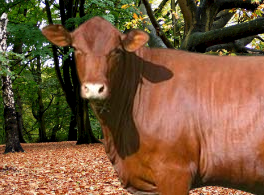Senepol cattle are a breed of beef cattle recognized for its distinct qualities and adaptability. Senepol cattle, which originated on the Caribbean island of St. Croix, have become increasingly popular throughout the globe.
Senepol Cattle Origin
Senepol cattle can be traced back to the late-19th century, when the first cross between N'Dama cattle and Red Poll cattle were made on the island of St. Croix. The N'Dama breed's heat tolerance and the Red Polls' superior meat quality were combined during the creation of the breed, which was developed specifically to thrive in tropical environments.
Pros of Senepol Cattle
Adaptation to Various Climates
The capacity of Senepol cattle to adapt to varied climates is one of its key advantages. These cattle are suitable for tropical and subtropical areas since they can survive in both hot and humid climates. They have evolved to make optimum use of available feed and to tolerate adverse climatic conditions.

Tolerance to Heat
Senepol cattle have a high level of heat tolerance, which is essential for livestock production in hot climates. They are more productive overall because of their capacity to control their body temperature, which helps to lessen heat stress.
Superior Fertility Rates
Senepol cows are noted for having high rates of conception. Shorter calving intervals are the result of their innate capacity to breed back soon after giving birth. This reproductive efficiency enables cattle ranchers to maintain a regular and productive breeding program.
Excellent Mothering Skills
Senepol cows have exceptional maternal skills. They are vigilant and careful of their calves, safeguarding their safety and well-being. This maternal conduct promotes healthier calves and enhances the general wellbeing and production of the herd.
Optimal Feed Conversion
Senepol cattle are renowned for converting feed efficiently. Compared to certain other breeds, they are more efficient at turning feed into meat. For cattle breeders, this trait increases profitability by lowering feed expenditures.
Cons of Senepol Cattle
Limited Market Demand
The low market demand for Senepol cattle in comparison to more widely used beef breeds is one of the key difficulties in raising them. Although the breed has gained popularity in some areas, it might be more difficult to find buyers for Senepol cattle, which could have an impact on market prices and overall profitability.
Longer Maturity Rate
Senepol cattle often mature more slowly than some other breeds. This indicates that it will take them longer to reach market weight. Producers who value higher turnover rates and quicker returns on investment may need to take into account the longer maturity rate.
Low Milk Production
Senepol cows produce less milk than other dairy-specific breeds on average. Senepol cattle may not be the best option if a cattle business includes a substantial dairy production component. The lesser milk production, however, might not be a big deal in terms of meat production.
Higher Initial Investment
When compared to other breeds, Senepol cattle may require a larger initial investment. This can be linked to variables such as breed reputation, availability, and probable transportation costs for importing cattle from locations where the breed is more prevalent.









0 Comments